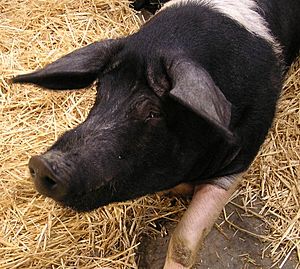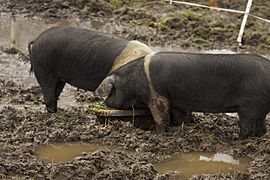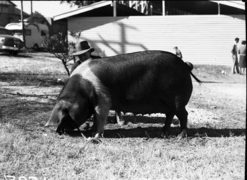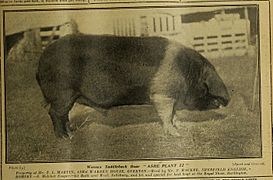Wessex Saddleback facts for kids

A Wessex Saddleback at the Sydney Royal Easter Show.
|
|
| Country of origin | England |
|---|---|
| Traits | |
|
|
The Wessex Saddleback is a special kind of pig that came from the West Country in England. You can find it in places like Wiltshire and the New Forest area. This pig is easy to spot because it's black with a white band around its front. In Britain, it joined with another pig called the Essex pig to create the British Saddleback. Because of this, the pure Wessex Saddleback no longer exists in Britain. But don't worry! You can still find them in Australia and New Zealand.
Contents
What Does a Wessex Saddleback Look Like?
The Wessex Saddleback is mostly black. It has a wide white stripe that goes over its shoulders and down to its front legs. This white stripe looks a bit like a saddle, which is how it got its name! These pigs are tall and strong. They are good at finding their own food in forests.
For a long time, these pigs were used to search for food in the woods. This tradition lasted longest in the New Forest. Here, pigs still look for "mast," which means acorns, beech-nuts, and chestnuts. However, the pigs in the New Forest today are not pure Wessex Saddlebacks.
The History of the Wessex Saddleback
No one is completely sure how the Wessex Saddleback pig first started. Some people think it came from mixing a black pig from the New Forest with an "Old English Sheeted breed." This happened in the 1700s in places like Hampshire. Others simply say its origin is unknown.
Some believe this pig breed was not much changed by mixing with pigs from the Far East. If this is true, the Wessex Saddleback might be very similar to the old "landrace" pigs. Landrace pigs were local pigs that lived and found food in the woods across Britain for many centuries.
Why the Breed Almost Disappeared
A group was formed in Britain in 1918 to protect the Wessex Saddleback. But by the mid-1900s, pig farming started to change. Farmers began raising pigs in smaller, more controlled spaces. The Wessex Saddleback was better suited for living in larger, outdoor areas. Because of these changes, the number of Wessex Saddleback pigs went down.
Another pig, the Essex pig, was also facing similar problems. So, in 1967, the Wessex Saddleback and the Essex pig were combined. This was done to try and save both breeds from disappearing completely. They created a new mixed breed called the British Saddleback. Sometimes, people in Britain still call the British Saddleback by the name "Wessex Saddleback."
A few pure Essex pigs survived in Britain. People are now trying to bring them back as their own separate breed. However, the Wessex Saddleback is now considered to be gone from its home country.
Where the Wessex Saddleback Lives Today
Before the breeds were combined, some Wessex Saddlebacks were sent to other parts of the world. Because of this, the breed still exists in small numbers today. You can find them in Australia and New Zealand. They might also be in other places.
In Australia, in 2008, there were fewer than 100 female breeding pigs. The Rare Breeds Trust of Australia considers them to be in serious danger of disappearing.
In the early 1800s, similar pigs from Hampshire were sent to North America. These pigs became the basis for the Hampshire pig. The Hampshire pig is now one of the most common farm pigs there. The Hampshire pig has since been brought back to Britain. But it looks different from the original Wessex pig.
What Were Wessex Saddlebacks Used For?
The Wessex Saddleback was known for its tasty meat. It was often raised to become "baconers." This means they were grown to make delicious bacon and hams.
Gallery




